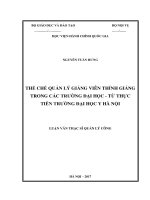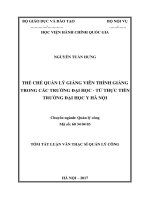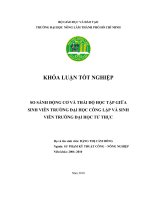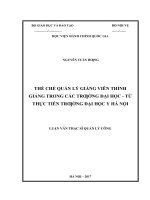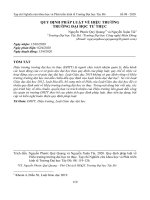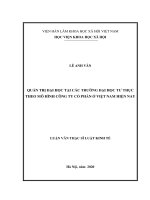tóm tắt: Quản lí liên kết đào tạo của trường đại học tư thục với doanh nghiệp tại thành phố Hồ Chí Minh đáp ứng yêu cầu thị trường lao động
Bạn đang xem bản rút gọn của tài liệu. Xem và tải ngay bản đầy đủ của tài liệu tại đây (300.22 KB, 27 trang )
<span class="text_page_counter">Trang 1</span><div class="page_container" data-page="1">
<b>HANOI NATIONAL UNIVERSITY OF EDUCATION</b>
<b>NGUYEN HUU NANG</b>
<b>MANAGEMENT OF TRAINING COLLABORATIONBETWEEN PRIVATE UNIVERSITIES AND</b>
<b>BUSINESSES IN HO CHI MINH CITY TO MEET THELABOR MARKET REQUIREMENTS</b>
<b>Major: Education managementCode: 9.14.01.14</b>
<b>DOCTORAL DISSERTATION SUMMARY IN EDUCATIONAL SCIENCE</b>
<b>Hanoi - 2024</b>
</div><span class="text_page_counter">Trang 2</span><div class="page_container" data-page="2"><b>Reviewer 2: Assoc. Prof. Dr. Mac Van Tien</b>
Directorate of Vocational Education
<b>Reviewer 3: Dr. Nguyen Quoc Tri</b>
Hanoi National University of Education
The dissertation will be defensed at the university level Board of Examiners
<i>At date month 2024</i>
<i><b>The doctoral dissertation can be found at:</b></i>
The National Library of Vietnam
The Hanoi University Library of Education
</div><span class="text_page_counter">Trang 3</span><div class="page_container" data-page="3"><b>INTRODUCTION1. Rationale for the study</b>
Collaboration of university education with businesses is a current trend in educationand a crucial factor in enhancing the quality of student training within the academicinstitutions. It is also a means to improve the quality of the workforce for society. Thecollaboration in education between universities and businesses assists the institutions inrefining their curriculum, ensuring alignment with industry requirements, addressing theinputs and outputs of the educational process, staying abreast of technologicaladvancements, and fostering the exchange of expertise. This collaborative effort contributesto the continual modernization of the university. From businesses’ perspective, participatingin the collaborative education efforts with universities is essential to ensure the cooperativedevelopment of the workforce. It facilitates the transfer of scientific and technologicalknowledge, enabling businesses to continuously improve and innovate their productionprocesses to remain competitive in the market economy.
Recognizing the importance of this collaboration, the Vietnamese Party andGovernment have particularly emphasized promoting training collaborations between highereducation institutions and enterprises, considering this as one of the key measures in thestrategy for reforming higher education. To implement this policy, the Government and theMinistry of Education and Training have issued various legal documents to establish a legalframework to promote and strengthen the collaboration between universities and enterprises.This is evidenced by documents such as Resolution No. 05/2005/NQ-CP, dated April 18,2005, which encourages the establishment of universities within major corporations andenterprises to enhance the effectiveness of human resource training and build strong linksbetween educational institutions and enterprises, and the amended Higher Education Law of2018, which in Article 12, Clauses 4 and 6, emphasizes encouraging the development ofprivate higher education institutions and linking training with the labor market needs.
In this context, private universities in Ho Chi Minh City have seen significantdevelopment in recent years, providing high-quality human resources for society andcontributing to the socioeconomic development of the city. Private universities, primarilymanaged by private organizations and enterprises, have contributed to training students invarious fields, from engineering, technology, and economics to healthcare, arts, and otherdisciplines. However, research from the Center for Labor Market Needs Forecast andInformation (Falmi) shows that there is still a high demand for skilled human resources.This includes 12.46% of the workforce having a university degree or higher, 17.04% with acollege degree, 26.04% with an intermediate level, and 27.38% with vocational or skilledworker qualifications. Moreover, the demand for practical skills also needs improvement, ascurrent training is heavily theoretical, not fully meeting the practical requirements of thelabor market. Studies also predict that the supply of human resources capable of meetingbusiness needs will continue to face shortages in the near future. To ensure the quality ofeducation and create job opportunities for students, private universities in Ho Chi Minh Cityneed to emphasize close cooperation with businesses. This collaboration helps create high-quality human resources, contributes to socioeconomic development, and meets thepractical requirements of the labor market.
</div><span class="text_page_counter">Trang 4</span><div class="page_container" data-page="4">In practice, in Ho Chi Minh City, despite significant progress in training collaborationsbetween private universities and businesses, there remain limitations such as a lack of stablecollaboration, lack of practicality in the training programs, and a shortage of necessary skillsrequired by the labor market. This results in unmet demand for high-quality humanresources. Therefore, researching and proposing effective solutions to manage and developthis collaboration, especially in a major economic hub like Ho Chi Minh City, will not onlyprovide valuable information for policymakers but also contribute to the overalldevelopment of the higher education system and the labor market.
<i><b>Given these issues, we have chosen the topic: "Management of training collaboration</b></i>
<i><b>between private universities and businesses in Ho Chi Minh City to meet the labor marketrequirements" as the research subject for this doctoral dissertation, with the aim of</b></i>
improving and contributing to the development of the higher education system and the labormarket at both regional and national levels.
<b>2. Aims of the study </b>
The study involves the theoretical foundation and Practical bases of trainingcollaboration and management of training collaboration between private universities andbusinesses. From this examination, proposed solutions for managing training collaborationbetween private universities and businesses in Ho Chi Minh City have been presented. Thegoal is to enhance the quality of education in private universities and contribute to providinga workforce that meets the current demands of the labor market in the city.
<b>3. Population and object of the study</b>
3.1. Population: Training collaboration activities in private universities.
3.2. Object: Solutions for management of training collaboration between privateuniversities and businesses in Ho Chi Minh City.
<b>4. Hypothesis of the study</b>
The system of private universities in Ho Chi Minh City is progressively expanding inboth scale and quality, making significant contributions to the current workforce for thelabor market. However, there are still shortcomings. One of the reasons is due to themanagement of training collaboration between private universities and businesses has yet toyield significant effectiveness. If the management solutions for educational collaborationbetween universities and businesses focus on solutions such as establishing mechanisms andpolicies for training collaboration between private universities and businesses that aresuitable for the Ho Chi Minh City area;; training to enhance awareness and responsibilityfor participants in the collaboration; steering collaboration with businesses in developingtraining programs and scales that meet the requirements of the labor market; steering theinnovation of training methods to emphasize practical experience at businesses; organizingcollaboration with businesses in education and career counseling, supporting employmentfor students; establishing a feedback information system between universities, students,alumni, and businesses.
<b>5. Research questions</b>
- What issues must private universities address in their management of trainingpartnerships with businesses to ensure that their educational products meet the labormarket's requirements, given the development of the market economy and the expansion ofthe private university system in Vietnam?
</div><span class="text_page_counter">Trang 5</span><div class="page_container" data-page="5">- What difficulties and obstacles need to be resolved in the management of educationalcollaborations between private universities and businesses in Ho Chi Minh City at present?
- Considering the unique characteristics of private universities and the specific contextof Ho Chi Minh City, what solutions are appropriate for private universities to effectivelymanage their training partnerships with businesses?
<b>6. Objectives of the study</b>
6.1. Investigating the theoretical backgrounds of training collaboration and themanagement of training collaboration between universities and businesses;
6.2. Assessing the current status of training collaboration and the management oftraining collaboration between private universities and businesses in Ho Chi Minh City;
6.3. Proposing management solutions for training collaboration between privateuniversities and businesses in Ho Chi Minh City;
6.4. Testing the proposed solutions.
<b>7. Scope of the study</b>
- Studying the collaboration between the academic level of private universities andbusinesses in Ho Chi Minh City.
- Studying the management of collaboration between the academic level of privateuniversities and businesses in Ho Chi Minh City from 2019 to 2022.
- The main subject in managing collaborative activities is the private universities.From the universities’ side, key personnel involved in managing collaboration includeuniversity-level administrators and unit-level administrators (Departments/ Faculties/Institutes/ Centers). From the businesses’ side, the focus is on the operational andmanagement departments of companies within Ho Chi Minh City.
<b>8. Approaches and research methods</b>
8.1. Approaches
The author employed a coordinated approach, including management functionapproach, process approach, labor market approach, supply-demand law approach, anduniversity autonomy approach.
8.2. Research mothods
The author utilized a combination of research methodologies: a group of theoreticalresearch methods and a group of practical research methods (product research, surveysusing questionnaires; discussions and interviews; summarization of experiences;experimentation).
8.3. Supplementary methods: including mathematical statistical methods, diagrams,and charts to illustrate the research results.
<b>9. Defence Arguments</b>
- In the current market economy, the management of training linkages between privateuniversities and businesses is considered a crucial factor for ensuring that the trainingprocess is aligned with practical needs, guaranteeing that the workforce is trained to meetthe requirements of the labor market.
- The management of training linkages at private universities must demonstrate theinstitution's proactive role in linkage activities, while these training activities should beintegrated throughout the training process, from entry through the training phases to theoutcomes.
</div><span class="text_page_counter">Trang 6</span><div class="page_container" data-page="6">- Private universities in Ho Chi Minh City, situated within the context of a majorVietnamese city and characterized by the nature of private institutions, necessitate traininglinkage solutions with businesses that are congruent with the local realities and thedistinctive features of private universities to achieve high effectiveness.
<b>10. Contributions of the study</b>
<i><b>10.1. Theoretical contributions</b></i>
The thesis systematically deepens the theoretical understanding of trainingcollaboration and the management of training collaboration between private universities andbusinesses to meet the labor market's requirements, In this regard, it identifies thecharacteristics of the training collaboration between private universities and businesses. Itanalyzes in detail the specific forms and contents of the training collaboration betweenprivate universities and businesses to meet the demands of the labor market, It identifiesfactors that influence the management of training collaboration between private universitiesand businesses.
<i><b>10.2. Practical contributions</b></i>
The thesis identifies the current situation, evaluates the advantages and limitations,analyzes the reasons behind the state of collaborative training activities, and managescollaborative training activities of private universities with businesses in Ho Chi Minh City.The goal is to train graduates who meet the demands of the labor market. From this analysis,the thesis develops a system of management solutions for collaborative training activities ofprivate universities with businesses. These solutions aim to be applied in the practicalmanagement of collaborative training activities, creating a conducive environment fortraining activities that align with the goal of meeting the labor market demands in Ho ChiMinh City.
<b>11. Structure of the dissertation</b>
Apart from the introduction, conclusion, and recommendations, bibliography, andappendices, the thesis is structured into three chapters:
<i>Chapter 1: Theoretical Backgrounds of Collaborative Training Management between</i>
Universities and Businesses to Meet Labor Market Demands.
<i>Chapter 2: The Current Status of Collaborative Training Management of Private</i>
Universities with Businesses in Ho Chi Minh City to Meet Labor Market Demands.
<i>Chapter 3: Solutions for Collaborative Training Management of Private Universities</i>
with Businesses in Ho Chi Minh City to Meet Labor Market Demands.
</div><span class="text_page_counter">Trang 7</span><div class="page_container" data-page="7">CHAPTER 1
<b>THEORETICAL BACKGROUNDS OF COLLABORATIVE TRAININGMANAGEMENT BETWEEN PRIVATE UNIVERSITIES AND BUSINESSES TO</b>
<b>MEET LABOR MARKET DEMANDS</b>
<b>1.1. Overview of the Research</b>
<i><b>1.1.1. Studies on training collaboration between universities and businesses to meetlabor market demands</b></i>
<i><b>1.1.2. Studies on the management of training collaboration between universities andbusinesses to meet labor market demands</b></i>
<i><b>1.1.3. General Evaluation of the Overview</b></i>
<i>1.1.3.1. Inheritable Perspectives</i>
Evaluating the awareness of the benefits of training collaboration between universitiesand businesses. The issue of training collaboration to meet the labor market through theimplementation of issue groups: knowledge sharing, research collaboration, serviceenhancement, changes in training content and methods. Evaluating the quality of trainingthrough collaboration between universities and businesses using various forms and methods.Identifying business needs to develop training programs and evaluating its achievementafter completion; Determining selection mechanisms to train high-potential talents;Establishing an online sharing platform to materialize business knowledge sharing; Buildingbusiness resource groups to integrate comprehensive resources.
<i>1.1.3.2. Issues Not Yet Addressed in Research</i>
Issues related to improving the quality of education through different approaches toexplore how to satisfy the requirements of the labor market. Evaluating the quality of theuniversities’ outputs in line with the labor market's requirements. The managementmeasures of private universities in training collaboration to meet the labor market demands.
<i>1.1.3.3. Issues the Thesis Needs to Focus on for Resolutions</i>
Based on the overview of research results, the thesis focuses on addressing thefollowing key issues:
(i) The theory of training collaboration between private universities and businesses tomeet the current labor market demands in Vietnam; Clarifying the fundamental factors oftraining quality to meet the labor market requirements in Vietnam.
(ii) Evaluating the current status of training collaboration between private universities andbusinesses through content and teaching methods during the training process; Assessing thecurrent status of training collaboration activities with businesses from the privateuniversities’perspective, evaluating the quality of training according to the labor marketrequirements, managing the content and forms of training collaboration between privateuniversities and businesses.
(iii) Proposing management solutions for training collaboration by private universitiesin the collaboration between private universities and businesses to enhance the quality oftraining towards meeting the requirements of the labor market
</div><span class="text_page_counter">Trang 8</span><div class="page_container" data-page="8"><b>1.2. Labor Market and Requirements for the Training Collaboration betweenPrivate Universities and Businesses to Meet Labor Market Demands</b>
<i>1.3.3. Form of training collaboration between private universities and businesses1.3.4. Content of training collaboration between private universities and businesses tomeet the requirements of the labor market: in executing input activities; tailoring thetraining process; and implementing output factors.</i>
<b>1.4. Managing Training Collaboration at Private Universities with Businesses toMeet Labor Market Requirements</b>
<i><b>1.4.1. The concept of the management of training collaboration between privateuniversities and businesses</b></i>
<i><b>1.4.2. Hierarchical Management of Training Collaboration at Private Universities:</b></i>
<i>Focusing on the roles of management levels, including the Presidents, Vice Presidents,Functional Departments, Specialized Departments, and Academic Units. Management levelsare responsible for developing strategies, plans, and regulations related to trainingcollaboration. Functional Departments such as Training, Student Affairs, Planning-Finance,and Facility Management play a crucial role in organizing, financing, and managing facilities.Specialized Departments and Academic Units are involved in developing training programs,research, and evaluating teaching and scientific research activities.</i>
<i><b>1.4.3. Content of the management of training collaboration between private universitiesand businesses to meet the requirements of the labor market: in the Implementation of input</b></i>
<i>activities; implementing the training process; implementing the output factors.</i>
<b>1.5. Factors influencing the management of training collaboration of privateuniversities with businesses to meet the requirements of the labor market.</b>
<i><b>1.5.1. Factors in the context affecting the management of training collaborationinclude: International integration in education can be seen as an opportunity but also a</b></i>
challenge for higher education in Vietnam; Progress in science and technology is acondition to promote socio-economic development, thereby leading to the emergence of anincreasing number of businesses in various forms; The growing labor market and itsfluctuations create competitive pressures on the reputation, training quality, brand, andtradition of universities; The development of the socio-economy increases the number ofbusinesses in large urban areas such as Ho Chi Minh City; The Party and State's humanresource development policies through frequent regulatory adjustments.
<i><b>1.5.2. Endogenous factors affecting the management of training collaborationinclude: Infrastructure and teaching equipment for students are insufficient; The practical</b></i>
teaching staff is lacking; The innovation in training is reflected in outdated content andmethods; The awareness of officials, teachers, and staff about training collaboration to meetthe requirements of the labor market is slow; Information about employment and the labormarket is not regularly updated.
</div><span class="text_page_counter">Trang 9</span><div class="page_container" data-page="9"><b>SUMMARY OF CHAPTER 1</b>
In this chapter, the dissertation accomplishes two objectives: an overview of theresearch problem and the establishment of a theoretical framework as a tool for examiningthe current situation and proposing solutions for the training linkages between privateuniversities and businesses to meet labor market requirements.
In the research overview section, the thesis focuses on surveying and evaluating bothdomestic and international literature on two main issues: the status of training linkagesbetween educational institutions and businesses in meeting labor market demands, and themanagement of these training linkages to fulfill labor market needs.
In the theoretical foundation section, besides establishing concepts, the dissertationhas developed a theoretical system on the training linkages of private universities withbusinesses that satisfy labor market demands and on managing such training linkages tomeet these requirements.
The approach to training linkages between universities and businesses utilizes the CIPOmodel to present the content of training connections of private universities with businessesacross each element of the training process to meet labor market demands: training linkages ofprivate universities with businesses in carrying out input activities, training linkages during thetraining process, and training linkages in executing output factors..
Issues in managing the training linkages of private universities with businesses areapproached from a management function perspective, to manage input activities that meet thelabor market demands through training linkages with businesses, manage the training process tosatisfy labor market needs through such connections, and manage output activities to fulfilllabor market demands through training linkages with businesses, among others.
Factors influencing the management of this training collaboration are analyzed byexamining the context through factors that promote or hinder the management of trainingcollaboration between universities and businesses in both objective and subjective aspects.
Through the theoretical framework established in Chapter 1, the author finds thattraining collaboration between educational institutions and businesses is an objectivenecessity, aligned with the trend of workforce development. However, the issue of trainingcollaboration and its management, the influencing factors, the conditions for establishingcollaboration, and the principles ensuring effective collaboration have not been fully orsystematically studied. Additionally, the management model for training collaboration hasnot received adequate attention.
On the other hand, to actualize the theory of training collaboration management, theestablishment of a relationship between universities and businesses must start from acommon understanding of the goals and benefits of the participating parties. The benefitsfor universities include the quality and efficiency of training, as well as the competitivenessof their brand. For businesses, the primary benefits are profit and capital. Therefore, in theprocess of establishing and managing collaborative relationships, conditional collaborationand corporate social responsibility must be considered, ensuring a sustainable and effectivepartnership environment aimed at long-term development for all parties. The principle ofrapid adaptation combined with training collaboration management, adopting the CIPOmodel, aims to provide a solid scientific foundation for studying the current situation andproposing solutions for this dissertation topic.
</div><span class="text_page_counter">Trang 10</span><div class="page_container" data-page="10"><b>CHAPTER 2</b>
<b>THE CURRENT STATUS OF COLLABORATIVE TRAINING MANAGEMENT OFPRIVATE UNIVERSITIES WITH BUSINESSES IN HO CHI MINH CITY TO</b>
<b>MEET LABOR MARKET DEMANDS.</b>
<b>2.1. Overview of private universities and businesses in Ho Chi Minh City</b>
<i><b>2.1.1. Brief overview of the private university system in Ho Chi Minh City</b></i>
The dissertation selected private universities in Ho Chi Minh City as the survey area.
<i><b>2.1.2. Overview of the business system in Ho Chi Minh City</b></i>
<b>2.2. Organization of the survey on the current situation</b>
<i><b>2.2.1. Purposes and subjects of the survey</b></i>
- The study aims to assess the current situation:
+ Training collaboration activities of private universities in Ho Chi Minh City withbusinesses
+ Management of training collaboration activities of private universities in Ho ChiMinh City with businesses
- Objectives: Collecting information and evaluating the level of activity, as well as thequality of training collaboration and the management of training collaboration with businesses ofprivate universities in Ho Chi Minh City to meet the requirements of the labor market.
<i><b>2.2.2. Survey content</b></i>
Evaluating perceptions of training collaboration, training collaboration activities, andthe quality of training collaboration between private universities and businesses in Ho ChiMinh City based on 05 levels.
Evaluating the extent of implementing the management of training collaborationactivities between private universities and businesses to meet the labor market requirementsin Ho Chi Minh City.
<i><b>2.2.3. Survey methods and data processing</b></i>
(i) Scale construction: Develop 03 sets of scales based on the research results on themanagement of training collaboration with businesses of private universities.
(ii) Scale testing: Conducting a pilot survey to check the logic of the scale beforeproceeding with data collection.
(iii) Data collection
- Quantitative survey and analysis:
+ For the status survey, a total of 663 quantitative survey questionnaires weredistributed. Among them, 354 teachers participated in responding to the questionnaire, 52management staff; 67 management staff from businesses; 75 alumni currently working inbusinesses; 115 final-year students.
+ For the evaluation of the necessity and feasibility of solutions, a total of 163quantitative survey questionnaires were distributed. The target groups include universitymanagement staff (63), teachers (60), practical guidance staff (18), and businessmanagement staff (22).
- Qualitative survey: For universities, interviews were conducted with 2-3management staff and teachers. For businesses, interviews were conducted with 1management staff in each business."
</div><span class="text_page_counter">Trang 11</span><div class="page_container" data-page="11"><i>2.2.3.1. Survey Method using Questionnaires </i>
<i><b>Sampling: The sample was selected using a stratified method, dividing the subjects</b></i>
into groups and randomly selecting from each group.
+ Sample of private universities: 4 universities were selected, accounting for 28.57% ofthe total number of private universities in Ho Chi Minh City.
+ Sample of teachers participating in the survey: 354 people, selected using YamaneTaro's formula to ensure reliability.
+ Sample of management staff from the 4 universities: 52 people, a ratio of 1/10compared to teachers.
+ Sample of final-year students: 115 people. Random selection method based on theindustries that the universities are currently training in.
+ Sample of final-year students: 115 people, randomly selected based on their majors. + Sample of alumni working in businesses: 75 people, randomly selected to ensure anadequate representation.
+ Sample of survey subjects, including management staff (directors, deputy directors,executives), and experts, technicians in businesses using human resources, who are alumni ofthe 4 selected universities: 67 people in 20 businesses, distributed by type of business: state-owned enterprises = 3; Foreign Direct Investment (FDI) enterprises = 2; private enterprises andjoint ventures with foreign businesses = 15; distributed by business scale: large enterprises = 9;medium-sized enterprises = 7; small enterprises = 4; micro-enterprises = 0.
<i><b> Processing questionnaire survey results:</b></i>
<i> + Value assignment: Use a 5-point evaluation scale from poor to excellent.</i>
+ Value range: Calculated from the minimum value to the maximum value. (Maximum- Minimum)/n = (5-1)/5 = 0.80
<i><b>+ Calculate the mean value (</b><small>X</small></i> ): Categorize from not good to very good.
<i>+ Use statistical tools: Use SPSS 20.0 software to process information from the survey.</i>
<i><b>+ Analyze statistical data: Use methods such as descriptive analysis and t-test. </b></i>
<i>2.2.3.2. Interview Method</i>
<i>- Interviewees: Includes management staff from 4 universities, management staff from</i>
20 businesses related to the 4 universities, final-year students from the 4 universities, andalumni of the 4 universities currently working in businesses.
- Conducting interviews: After collecting survey questionnaires, interviews wereconducted to clarify information from the analysis of the data.
- Using interview information: Information from interviews was used to reference and clarify information from the survey data.
<i>cross-2.2.3.3. Product Research Method</i>
- Research sample: including documents from the Department of Labor - Invalids andSocial Affairs of Ho Chi Minh City, the Ministry of Planning and Investment, the Center forForecasting Demand and Human Resources of Ho Chi Minh City, and documentsdemonstrating the "Three Disclosures" of the Quality Assurance Center of privateuniversities in Ho Chi Minh City.
- Procedure: document research, access websites to collect information and analyze content.- Information processing: synthesizing data into statistical tables and make conclusionsbased on these figures.
</div><span class="text_page_counter">Trang 12</span><div class="page_container" data-page="12"><b>2.3. Current Status of labor market demands in Ho Chi Minh City</b>
<i><b>2.3.1. Recent Developments in Enterprise Growth in Ho Chi Minh City</b></i>
<i><b>2.3.2. Human Resource Demand in the Labor Market ofEnterprises in Ho Chi Minh City</b></i>
<b>2.4. Current Status of Training Collaboration between Private Universities andBusinesses in Ho Chi Minh City to Meet Labor Market Demands</b>
<i><b>2.4.1. Current Status of Training Collaboration between Private Universities andBusinesses in executing input activities</b></i>
<i><b>2.4.2. Current Status of Training Collaboration between Private Universities andBusinesses in the Training Process</b></i>
<i><b>2.4.3. Current Status of Training Collaboration between Private Universities andBusinesses in implementing output factors</b></i>
<i><b>2.4.4. General Evaluation of the Current Status of Training Collaboration betweenPrivate Universities and Businesses in Ho Chi Minh City</b></i>
<i>(i) The Process of Collaborative Training Activities</i>
The collaborative training activities of the private universities with businesses in HoChi Minh City were assessed comprehensively, covering various collaboration activities thatserve enrollment processes, Curriculum development, Enhance the proficiency of the staff,teachers and employees, Enhancement of financial and material facilities, Improving thequality of education, vocational education, and career counseling activities, as well asvarious forms of student evaluation based on output standards. Overall, the surveyedcollaboratiive training activities have occurred with different evaluation levels. Table 2.27below illustrates that the majority of the collaborative training activities were evaluated atan average level. Specifically, the collaboration in enrollment activities was rated belowaverage by both parties (= 2.44 and 2.34). Looking at the overall evaluation of the sevenareas of the training process in Table 2.27, the evaluation from the private university'sperspective is higher than the evaluation from the business perspective. This reflects twopossibilities: either the university actively requests participation in training collaboration,but the acceptance or engagement of businesses in this process does not achieve the desiredresults, or the collaborative training activities of private universities with businesses are notconducted regularly and consistently in terms of organization and management. It is alsopossible that private universities may not have enough credibility in education and socialresponsibility, thus failing to attract businesses to participate in the training process.
<i><b>Table 2.27. Overall evaluation of collaborative training activities of private universities</b></i>
</div><span class="text_page_counter">Trang 13</span><div class="page_container" data-page="13">6 Career Guidance and Employment Support 3.08 2.937 Evaluation of Output Quality 3.03 2.95
<i>(ii) Quality of education assessed based on labor market responsiveness</i>
In general, the quality of education provided by private universities is rated asaverage in meeting the demands of the labor market. This implies that the human resourcetraining offered by these private universities in Ho Chi Minh City is not sufficientlyadaptable to the changes in the labor market due to the dynamic and complex nature of theeconomy and job market. This poses a challenge for administrators to find solutions toenhance the quality of education, with a focus on training partnerships with businesses as abreakthrough step toward competency-based approaches that align with the practical needsof enterprises. Evaluations of the six mentioned activities from both sides - privateuniversities and businesses - only reach an average level, with private universities beingslightly more positive in their evaluations compared to businesses. Out of the six activities,four are evaluated by students, and the results are summarized in the table below:
<i><b>Table 2.28</b></i><small>. Student Feedback on the Quality of Education</small>
TT <sup>Students evaluating the outcomes of the training</sup>collaboration through various activities.
Degree of evaluation
1 Evaluating the admissions process 3.052 Evaluating the training program 3.123 Assessing the training collaboration 2.934 Evaluating the collaboration to ensure output standards 3.00
The data presented in Table 2.28 indicates that the collaborative activities betweenprivate universities and the businesses, as assessed by students, are at an ‘average’ level. Allfour evaluation criteria mentioned fall within the framework of the CIPO model.Admissions work and training programs belong to the “input” factor, the collaborativetraining process pertains to the “process” factor, and the linkage to ensure output standardsfalls under the “output” factor. Student evaluations of these activities fall under the 'context'factor. Among these factors, opinions on 'input' receive higher ratings compared to the otherfactors. This suggests that the relationship between the 'context' factor and the 'input' factoris stronger than its relationship with other factors. While the content of activities under the“output” factor in Table 2.27 is highly rated by both the private university and thebusinesses, the activities related to the 'process' factor need to be addressed more activelyand effectively. These activities are the focal point of training collaboration, where studentsneed to learn in the best conditions, closely aligned with the practical aspects of professionalactivities after graduation.
<b>2.5. Current Status of Collaborative Training Management ofPrivate Universities with Businesses in Ho Chi Minh City inResponse to Labor Market Demands</b>
<i><b>2.5.1. Current Status of Collaborative Training Management of Private Universitieswith Businesses in the Implementation of Input Activities</b></i>
<i><b>2.5.2. Current Status of Collaborative Training Management of Private Universitieswith Businesses in the Training Process</b></i>
<i><b>2.5.3. Current Status of Collaborative Training Management of Private Universitieswith Businesses in implementing output factors </b></i>
</div>